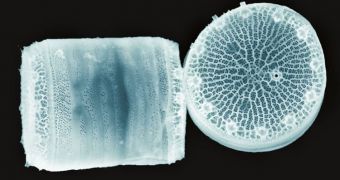Researchers at the US Department of Energy's (DOE) Pacific Northwest National Laboratory (PNNL) announce the development of a new fluorescent biosensor, which relies on the natural glowing abilities of microscopic marine algae called diatoms.
One of the most remarkable things about these microorganisms is that they are able to glow when a foreign substance is introduced in their environments. By emulating this trait, scientists may be able to develop a new category of metamaterials.
The latter would allow experts to build new tools for biological sensing, chemical catalysis and environmental mitigation. The PNNL group says that fluorescence is key for all these materials.
The biosensor they created contains a diatom shell that has fluorescent proteins embedded throughout its structure. These molecules are sensitive to specific substances, so exposing the sensors to these chemicals causes them to glow.
“Like tiny glass sculptures, the diverse silica shells of diatoms have long intrigued scientists. And the way our biosensor works could make diatoms even more attractive to scientists because it could pave the way for the development of novel, synthetic silica materials,” Kate Marshall explains.
The expert holds an appointment as a molecular biologist at the PNNL Marine Sciences Laboratory, in Sequim, Washington. She was also the lead author of a new paper detailing the findings, which is published in the latest issue of the journal PLoS ONE.
“With this research, we've made our important first steps to show it's possible to genetically engineer organisms such as diatoms to create advanced materials for numerous applications,” Marshall adds.
She explains that diatoms are very easy to study, and easy to harvest, since these microorganisms make up the vast majority of phytoplankton. The latter is the basis for marine food webs, and therefore widespread throughout Earth's oceans.
An important accomplishment was creating a biosensor that can function outside of a living diatom. This means that only the alga's shell was used in conjunction with the proteins, not the entire organism.
The new study also included experts from the PNNL Environmental Molecular Sciences Laboratory.

 14 DAY TRIAL //
14 DAY TRIAL //